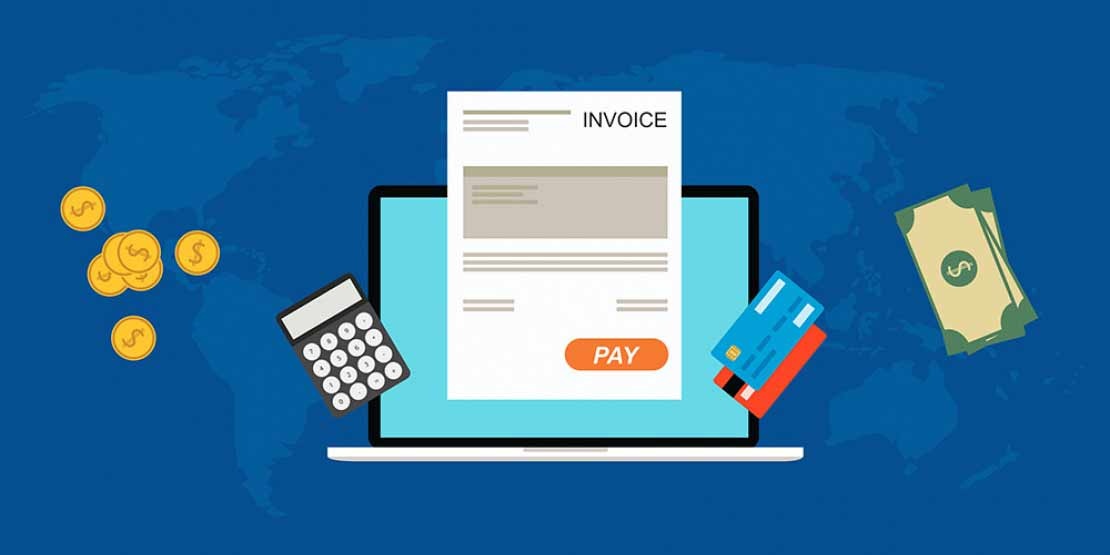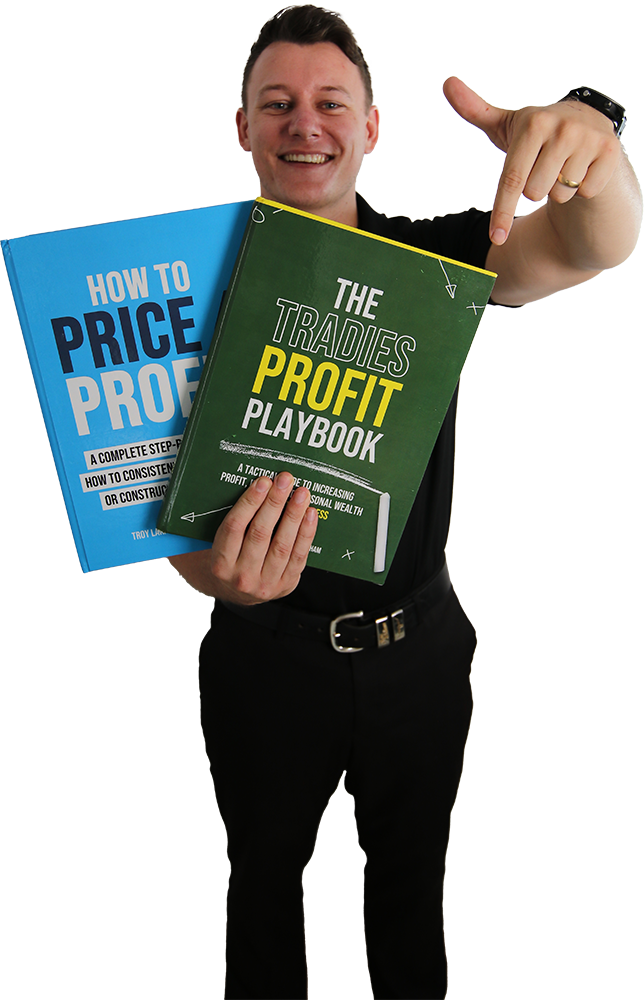One of the biggest areas that I’m seeing trade and construction business owners falling down is collecting money from their clients and customers.
But the way that you invoice has a massive impact on the profit of your business… and so, in today’s video I’m going to show you exactly what that impact is, how the smallest slip ups around invoicing can affect your overall income… and some ways that you can overcome this and start collecting cash from your customers much, much faster.
For those who don’t know me, my name is Bayley Peachey, client advisor at Trade Business Accountants where we help trade and construction business owners scale their profits and cash.
We make these videos because we want you to make a lot of money from them and then hopefully, you’ll apply to work with us to scale that even further in a lot less time.
So, with that being said… Let’s get stuck in.

Let’s face it, when things get busy, invoicing isn’t always at the top of the to do list. It can very easily sit on the back burner I get that.
But here’s the thing...
For every day that you don’t invoice your clients, you are literally pushing back your own payday and even worse, you’re pushing back the chances that you’ll even get paid at all.
Because the longer that invoice is delayed the stronger the chance that your customer will dispute the claim, or not want to pay at all, or even go into witness protection where you never hear from them again no matter how hard you try to get into contact.
So not only are you not going to get your money, but you’re also going to waste a lot of your time too, and what’s that costing you?
So, let’s kick things off with three common mistakes that I see when it comes to invoicing.
Mistake number one: Believing that because you deliver a great service, the client will automatically pay.
If you don’t have clear payment terms and conditions that were communicated up front and agreed upon in writing, and if you don’t send an invoice, then it doesn’t matter how good your service is… that money isn’t going to automatically find itself sitting in your bank account.
Mistake number two: Believing that the client knows how much is owed and will just pay the amount promptly.
An invoice triggers the payment cycle, and a client has no obligation to pay you until an invoice has been received, so if an invoice is not sent in a timely manner, there’s no guarantee payment will be made on time. You can’t just believe that every client understands what’s expected of them and that every client will be jumping to pay you as fast as possible on their own…
Mistake number three: Forgetting to send the clients an invoice and ‘working for practice’.
If an invoice goes out days, weeks or even months after the job was finished, then payment will be received days, weeks or even months later. And if you forget to send an invoice altogether, then guess work, you’ll never see it!
I know this sounds obvious but this is such a common problem that I’m seeing.
Probably far more common than you think too…
And it’s not like you don’t know that you need to be sending invoices to your clients and charging for what you do… like I was saying earlier half the time you just get so busy that things slip by…
But I believe that we often need to be reminded more than we need to be taught.
Running a trade business can be busy work… yes…. things can slip below the radar here and there… and it isn’t always easy to be across this stuff… yes… so, this is your reminder to stay on top of your invoicing and stay on top of who owes you money.
Because no one in this industry should be in the business of working for free or playing for practice.
You can go broke sitting on a beach.
So, why do it working your arse off?
Invoicing should be done at the click of a button, and not be an annoying task that gets put on the back burner every week and I’ll dive into the numbers to show you why.
On average, 5-15% of revenue goes uncollected every year.
Which is A LOT of work being delivered for FREE.
Let’s say you do $1,000,000 in sales.
And just 5% of that, on the lower end here, goes uncollected.
5% of $1,000,000, we’re talking $50,000.
Now you might be thinking well what’s $50,000 when we’re pulling in $1,000,000… sometimes things happen in business, if I don’t collect $50k I can probably live with that?
But let’s break it down.
Say you have a gross profit margin of 25%.
25% of $1,000,000 is going to come out to $250,000.
That’s $250,000 that should be your gross profit.
But because of this lost $50,000… this uncollected $50,000… your gross profit is actually only going to be $200,000… so suddenly this seems like a of money now, right?
Especially considering that the lost $50,000 that you didn’t collect, is 20% of your entire gross profit margin!
To make up for this you’re going to need an additional $200,000 on top of this just to get your gross profit back.
But here’s where it gets really scary…
Let’s talk about how this impact the bottom line!
Say in this same scenario… where you do $1,000,000 in sales… and just 5% goes uncollected…
You have a net profit margin of 10%.
This means that $100,000 of that $1,000,000 should be profit on top of your salary.
But because of the lost $50,000 worth of sales, your profit is actually only $50,000.
That lost $50,000… which believe me… is a very probable scenario… means that you’ve lost 50% of your bottom-line profit.
Now, to get THIS back… you’d need another $1,000,000 worth of sales just to get your profit back to where it should be if you actually collected all of the money owed to you by your clients.
Which is just insane…
You’d have to literally double your sales; you’d have to do an extra million dollars’ worth of work just to get your profit back.
So, you need to be collecting money much, much FASTER in your business which comes down ultimately to how you’re invoicing.
Because sale only ends once money exchanges hands.
I know an electrical contractor that at the time was growing rapidly, but wasn’t staying on top of their invoicing and tracking their receivable days… and it turns out he was so busy winning work and delivering projects that he had over $700,000 dollars he hadn’t collected over the past two years that he had completely forgotten about…
So, don’t let that be you!

We’ve seen what effect and damage even a small amount of uncollected money can do to your business through this little example, let alone an amount like $700,000.
It doesn’t matter how many sales you do or what annual turnover you’re pulling if cash isn’t hitting your bank account!
So, let’s cover some ways that you can fast track the rate at which you are collecting cash from your customers.
First of all, let’s start with what’s already outstanding
Use your accounting software to generate a report of what money you have outstanding and who owes it to you and then change the settings to re-arrange that list in order of most overdue and start the follow up process.
Call, and email, Call, and email. Call, and email, and start chasing those payments.
Re-directing our focus to incoming work…
Communicate your prices and payment terms up front.
Hourly rate, quoted, inclusions/exclusions, whatever it is, this is all about educating our customers and clients on how we do business and most importantly what we expect from them.
You need to train your customers on how you operate… it’s your business so you set the terms wherever possible.
Also get approval and a written signature before starting ANY works – which goes for variations too… and a side note there is also make sure you’re actually charging for variations!
Get a deposit whenever possible.
I know this isn’t always possible depending on what you do but aim to reduce what you need to collect from a customer once you finish your work and speed up the rate at which you collect… that’s the point here.
In alignment with that too, take payment on completion. If that’s not possible, shorten your payment terms and get them to a 7-day account!
If all your work is with builders and the like on 60-90-day terms, what you want to do is get crystal clear on how their payment system operates so that you aren’t caught out with something as simple as not understanding their payment cycles and dates correctly… because if you’re on a 30 day contract and you miss the deadline to submit your claims and you’re forced to wait another 30 days that’s going to crush you.
Also, seek to build a great relationship with the builder and the accounts person - basically anyone who holds the key to the kingdom and is responsible for making sure you get paid.
Now, circling back to the entire point of this video… invoice your customers as soon as possible!
Too many contractors just aren’t invoicing quick enough…
The average time between invoicing a client and receiving payment in Australia is 44 days.
That’s 44 days without cash that’s owed to you in some cases best case scenario…
So, the faster you invoice, the faster you get paid.
Get the money in your bank account as fast as possible that is the aim of the game my friends.
And lastly… follow up relentlessly.
You need to have a system in place to follow up and chase your money.
You’ve already done the work… so you deserve to be paid for it.
Don’t just assume that because you’ve sent an invoice, everyone will automatically follow your payment terms.
You’re going to need to have a system in place to follow up and collect what is owed to you - and you should be doing that weekly.
Set aside the time or make someone on your team responsible for collecting debt weekly and reducing the amount of money owed to your business.
Make it a weekly commitment.
That’s my advice here guys…
So, stay on top of your invoicing and stay on top of the money owed to you by your clients.
If you're an electrician, plumber, painter, carpenter, or any other tradie business owner turning more than $1M a year looking for assistance with your tax, accounting, bookkeeping, and business advisory - click here to learn more!

